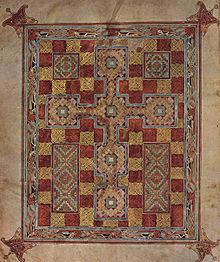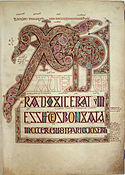Ewangeliarz z Lindisfarne
Ewangeliarz z Lindisfarne (łac. Codex Lindisfarnensis) – iluminowany manuskrypt powstały na początku VIII wieku w klasztorze Lindisfarne, zawierający łaciński tekst czterech Ewangelii. Reprezentuje jedną z najlepszych edycji tekstu Wulgaty, bliską Kodeksowi Amiatyńskiemu. W wydaniach krytycznych oznaczany jest symbolem Y[1].
Księga składa się z 259 pergaminowych kart formatu 340×235 mm[2]. Oryginalna oprawa nie zachowała się i w latach 1852-1853 wykonano nową, z drewna dębowego obłożonego czerwonym aksamitem i pokrytą srebrem oraz szlachetnymi kamieniami[3]. Uważany za jeden z najpiękniejszych przykładów insularnej sztuki iluminatorskiej manuskrypt zawiera m.in. ozdobne inicjały, ornamenty zwierzęce i portrety czterech ewangelistów. Każda z czterech Ewangelii poprzedzona jest ozdobną kartą nazywaną „dywanową”, przedstawiającą ornament geometryczny oparty na położonym centralnie krzyżu[4]. Zgodnie z treścią dodanego w X wieku przez mnicha Aldreda kolofonu księga została sporządzona przez Eadfritha, opata w Lindisfarne w latach 698-721, na cześć św. Kutberta. Aldred dodał także do łacińskiego tekstu jego interlinearny przekład na język staroangielski.
Manuskrypt przebywał na Lindisfarne do 875 roku, kiedy to mnisi opuścili klasztor w związku z najazdem duńskim. W 995 roku trafił do katedry w Durham. Po sekularyzacji dóbr kościelnych przez Henryka VIII w 1539 roku dostał się w prywatne ręce. Na początku XVII wieku stanowił część zbiorów antykwariusza Roberta Cottona (1571-1631). Od 1753 roku księga stanowi własność British Library.
Galeria
Zobacz też
Przypisy
- ↑ Robert F. Hull Jr., The Story of the New Testament Text. Movers, Materials, Motives, Methods, Society of Biblical Literature, Atlanta 2010, s. 94.
- ↑ Stan Knight, Historical Scripts. From Classical Times to the Renaissance, Oak Knoll Press, New Castle 1998, s. 45.
- ↑ Roy M. Liuzza and A. N. Doane, Anglo-Saxon manuscripts in microfiche facsimile, Volume 3: Anglo-Saxon Gospels, Center for Medieval and Early Renaissance Studies, Binghamton 1995, s. 3.
- ↑ Klára Csapodiné Gárdonyi, Iluminowane kodeksy europejskie, Ossolineum, Wrocław 1984, s. 100.
Bibliografia
- The Oxford Dictionary of Art, Oxford University Press, Oxford 2004.
Media użyte na tej stronie
Folio 27r from the Lindisfarne Gospels, incipit to the Gospel of Matthew. The main text contains the first sentence of the Gospel According to Saint Matthew: "Liber generationis Iesu Christi filii David filii Abraham" ("The book of the generation of Jesus Christ, the son of David, the son of Abraham").
The first line contains the word "liber" ("the book") with illuminated letters in insular majuscule; the first three letters ("lib") are much more ornate than the last two ("er") in white. The next two lines are in runic capitals (i.e. Latin letters in a rune-inspired script, also seen in the Book of Nunnaminster for example): the first of these lines partially contains the word "generationis" ("generation" in the genitive case) as "-onis" appears in the next line, followed by the contracted form of "Iesu", namely "Ihu" with a tilde on the "h"; this type of contraction is called a nomen sacrum.
The last line is in insular majuscule and begins with another nomen sacrum, the contraction "χρi" with a tilde, meaning "Christi". This is followed by a more compressed series of words. The first is "filii" ("son", genitive) with an "fi" ligature and a letter "l" with two stacked "i" letters on its leg. Then "David" is seen and is formed with a letter "d" with an "a" stacked on a "v" in its counter followed by "id". After that, "filii" is present again, however this time the "fi" ligature is replaced with the Greek letter phi (φ) due to its phonetic similarity. The last word is "Abraham", which is split into two lines.Folio 209v of the Lindisfarne Gospels showing John the Evangelist.
Autor: Pat Alexander, Licencja: CC BY 3.0
The opening page of Mark's Gospel, in the Lindisfarne Gospels. This manuscript was made by monks at the monastery of Linisfarne, an island off the coast of Northumbria, England, circa 700.
Page with Chi Rho monogram from the Gospel of Matthew in the Lindisfarne Gospels.











